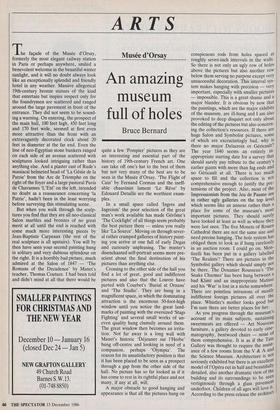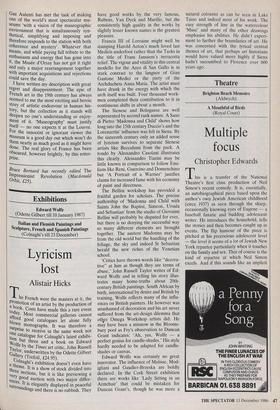ARTS
Musee d'Orsay
An amazing museum full of holes
Bruce Bernard The façade of the Musee d'Orsay, formerly the most elegant railway station in Paris or perhaps anywhere, smiled a benevolent welcome in the beautiful winter sunlight, and it will no doubt always look like an exceptionally splendid and friendly hotel in any weather. Massive allegorical 19th-century bronze statues of the kind that entertain but inspire respect only for the foundrymen are scattered and ranged around the large pavement in front of the entrance. They did not seem to be sound- ing a warning. On entering, the prospect of the main hall, 100 feet high, 450 feet long and 170 feet wide, seemed at first even more attractive than the front with an extravagantly decorated clock about 20 feet in diameter at the far end. Even the line of neo-Egyptian stone bunkers ranged on each side of an avenue scattered with sculptures looked intriguing rather than anything else. And a plaster cast of Rude's maniacal helmeted head of 'La Genie de la Patrie' from the Arc de Triomphe on the right of the foyer and a large pastoral Puvis de Chavannes `L'Ete' on the left, intended no doubt as a reassurance concerning 'la Patrie', hadn't been in the least worrying before surveying this stimulating scene.
But when you walk through the sculp- tures you find that they are all neo-classical Salon marbles and bronzes of no great merit at all until the end is reached with some much more interesting pieces by Jean-Baptiste Carpeaux (the rest of the real sculpture is all upstairs). You will by then have seen your second painting hung in solitary and very dubious splendour on the right. It is a horribly bad picture, much admired at the Salon of 1847 — 'The Romans of the Decadence' by Manet's teacher, Thomas Couture. I had been told and didn't mind at all that there would be quite a few Tompier' pictures as they are an interesting and essential part of the history of 19th-century French art. One can take off one's hat to the best of them but not very many of the best are to be seen in the Musee d'Orsay. The Flight of Cain' by Fernand Corman and the ineff- able chauvinist lament 'Le Rove' by Edouard Detaille are the worthiest exam- ples.
In a small space called 'Ingres and Ingreism' the poor selection of the great man's work available has made Gerome's `The Cockfight' of all things seem probably the best picture there — unless you really like 'La Source'. Moving on through sever- al rather cramped galleries of history paint- ing you arrive at one full of early Degas and curiously unpleasing. The master's disenchanted self-portrait seems more pre- scient about the final destination of his pictures than anything else.
Crossing to the other side of the hall you find a lot of great, good and indifferent pictures and also that the Louvre have parted with Courbet's 'Burial at Ornans' and 'The Studio'. They are hung in a magnificent space, in which the dominating attraction is the enormous 50-foot-high window until you notice the great land- marks of painting with the oversized 'Stags Fighting' and several small works of un- even quality hung clumsily around them. The great window then becomes an irrita- tion. Not far away is a long wall with Manet's historic Dejeuner sur l'Herbe' hung off-centre and looking in need of a companion, perhaps 'Olympia'. The reason for its unsatisfactory position is that it has been placed to be seen as a prospect through a gap from the other side of the hall. No picture has so far looked as if it has come to rest in its rightful place and not many, if any at all, will.
A major obstacle to good hanging and appearance is that all the pictures hang on conspicuous rods from holes spaced at roughly seven-inch intervals in the walls. So there is not only an ugly row of holes above the pictures but also another row below them serving no purpose except very unsuccessful decoration. This interval sys- tem makes hanging with precision — very important, especially with smaller pictures — impossible. This is a great shame and a major blunder. It is obvious by now that the paintings, which are the major exhibits of the museum, are ill-hung and I am also provoked to deep disquiet not only about the editing of the pictures but also concern- ing the -collection's resources. If there are huge Salon and Symbolist pictures, some of which are excruciatingly bad, why is there no major Delacroix or Gericault? The year 1840 seems an entirely in- appropriate starting date for a survey that should surely pay tribute to the century's earlier giants with more than fag ends and no Gericault at all. There is too much space to fill and the collection is not comprehensive enough to justify the pre- tensions of the project. Also, most of the Impressionists from the Jeu de Paume are in rather ugly galleries on the top level which seems like an annexe rather than a place for some of the museum's most important pictures. They should surely have looked at least as well as where they were last seen. The five Monets of Rouen Cathedral there are not the same size and need precise hanging. The hole system has obliged them to look as if hung carelessly in an auction room. I could go on. Mon- ticelli has been put in a gallery labelled `The Realists'! There are pictures in the Symbolist gallery which should simply not be there. The Douanier Rousseau's 'The Snake Charmer' has been hung between a bad Klimt and an inappropriate Matisse and his 'War' is lost in a niche somewhere. There are pointless intrusions of mostly indifferent foreign pictures all over the place. Whistler's mother looks good but I'm sure there are better places for her. As you progress through the museum's account of its main subjects, sustaining sweetmeats are offered — Art Nouveau furniture, a gallery devoted to early tine' matography, bentwood chairs — none of them comprehensive. It is as if the Tate Gallery was thought to require the assist- ance of a few rooms from the V & A and the Science Museum. Architecture is not seriously exhibited but there is an excellent model of l'Opera cut in half and beautifullY detailed, also another dramatic view of the building and its surroundings to be seen vertiginously through a glass pavement underfoot. Children of all ages will love it. According to the press release the architect Gae Aulenti has met the task of making one of the world's most spectacular mu- seums 'with a vision of the museographic environment that is simultaneously syn- thetical, simplifying and imposing and therefore responds to the station with both coherence and mystery'. Whatever that means, and while paying full tribute to the enthusiasm and energy that has gone into it, the Musee d'Orsay has not got it right and only a major rearrangement together with important acquisitions and rejections could save the day. I have written my description with great regret and disappointment. The epic of French art in the 19th century has always seemed to me the most exciting and heroic story of artistic endeavour in human his- tory, but the collection as it stands will deepen no one's understanding or enjoy- ment of it. `Museography' must justify itself — no one expects it at the Louvre. For the innocent or ignorant viewer the museum is a good day out which won't do them nearly as much good as it might have done. The real glory of France has been obscured, however brightly, by this enter- Prise.
Bruce Bernard has recently edited The Impressionist Revolution (Macdonald Orbis, £25).



































































 Previous page
Previous page